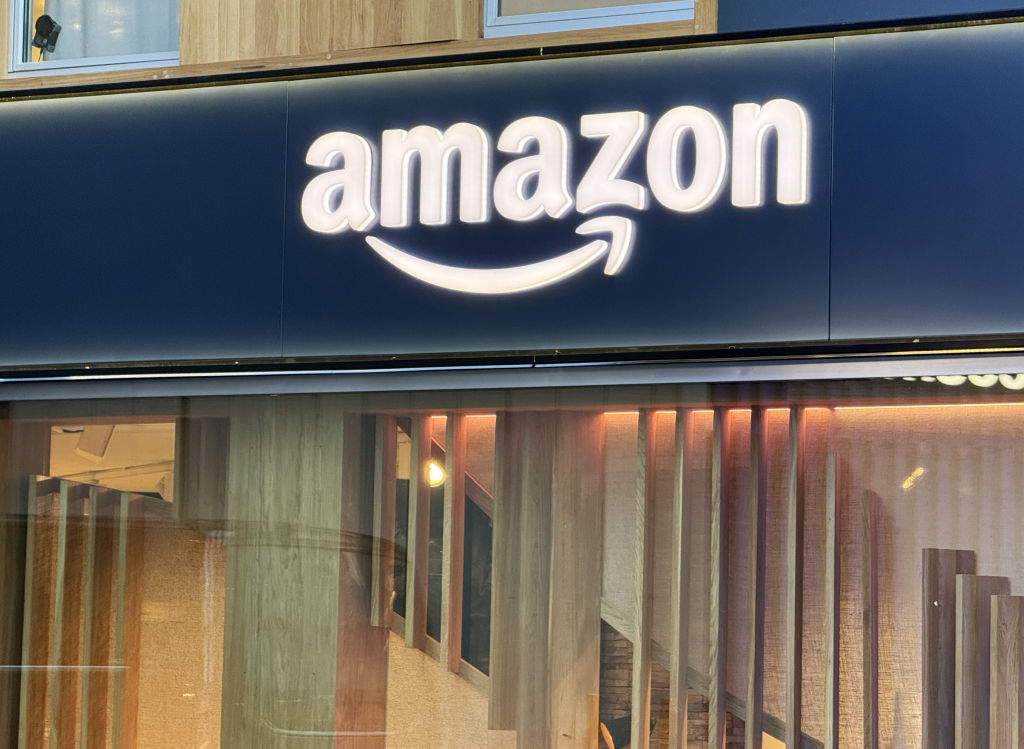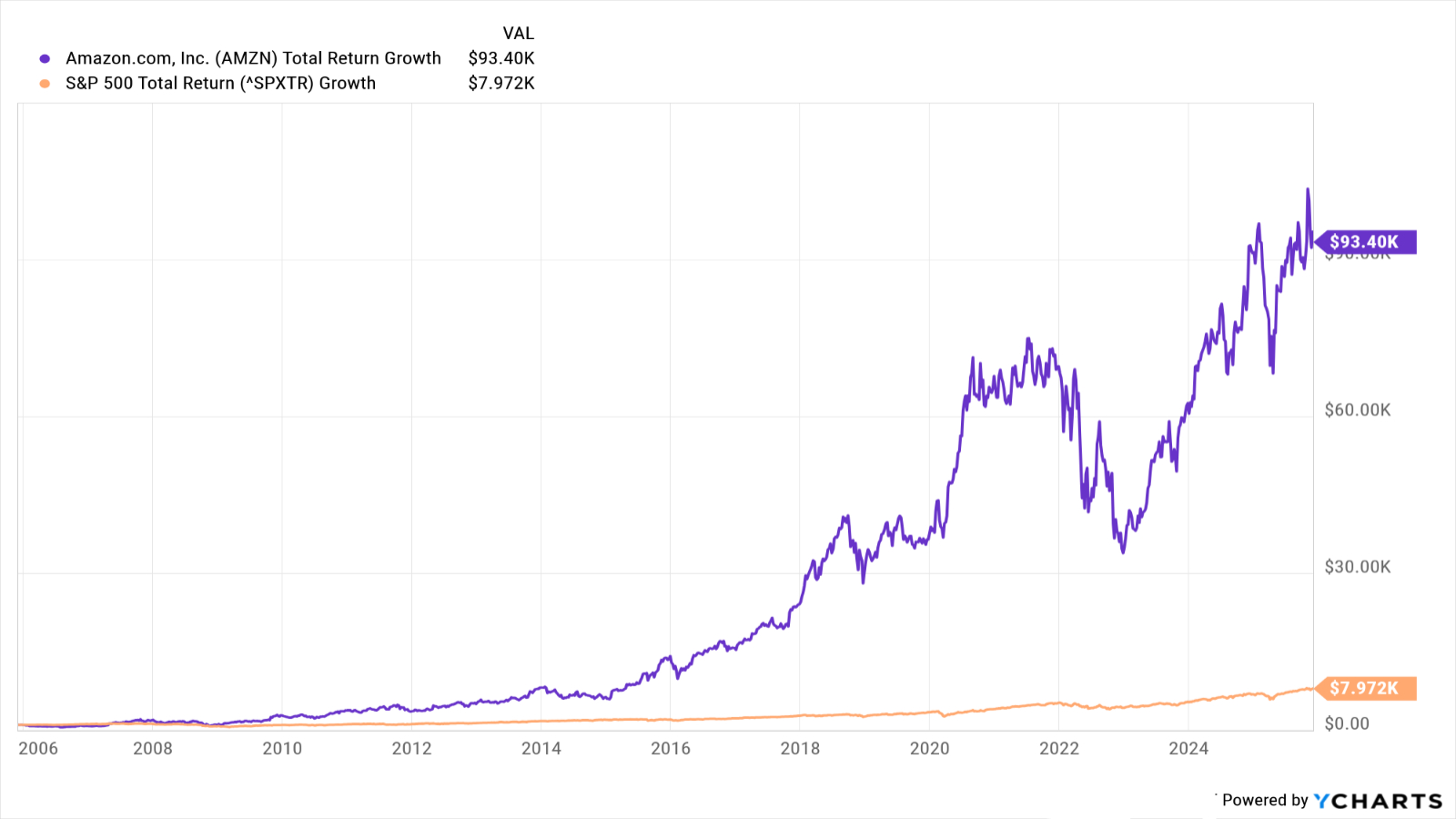If You'd Put $1,000 Into Amazon Stock 20 Years Ago, Here's What You'd Have Today
Amazon stock is lagging the broader market badly this year, but it's still been a buy-and-hold investor's best friend.



Amazon.com (AMZN) stock is underperforming the broader market by a wide margin so far this year, but it's been a remarkably remunerative bet for long-term shareholders.
Truly patient investors in Amazon stock have enjoyed astonishing returns through the decades.
Amazon, which joined the Dow Jones Industrial Average in February 2024, suffered some profound sell-offs over the years. At one point during its history, from peak to trough, Amazon stock lost more than half its value, wiping out more than a trillion dollars in market value.
From just $107.88 $24.99 for Kiplinger Personal Finance
Become a smarter, better informed investor. Subscribe from just $107.88 $24.99, plus get up to 4 Special Issues

Sign up for Kiplinger’s Free Newsletters
Profit and prosper with the best of expert advice on investing, taxes, retirement, personal finance and more - straight to your e-mail.
Profit and prosper with the best of expert advice - straight to your e-mail.
That's just the price of admission to one of the best stocks of all time.
An analysis by Hendrik Bessembinder, finance professor at the W.P. Carey School of Business at Arizona State University, found that AMZN was one of the 30 best stocks in the world through three decades.
Between its initial public offering in 1997 and December 2020, Amazon stock created nearly $1.6 trillion in wealth for shareholders, according to Bessembinder's model, which includes cash flows in and out of the business and other adjustments.
Amazon started as a modest website for book buyers. Today, it's the nation's largest e-commerce company.
That's only part of the story behind its extraordinary wealth creation. The firm is a giant in cloud-based services and artificial intelligence (AI), and a leader in streaming media and digital advertising.
Amazon has a massive footprint in the analog world, too. It owns the Whole Foods grocery store chain and maintains sprawling logistics operations. The latter comprise a vast assemblage of distribution centers and fleets of commercial aircraft and trucks, among other capital-intensive assets.
The bottom line on Amazon stock?
Which brings us to what $1,000 invested in Amazon stock 20 years ago would be worth today.
As you can see in the chart, if you'd invested $1,000 in Amazon stock a couple of decades ago, it would today be worth about $93,000. That's good for an annualized total return of almost 26%.
By comparison, the same sum invested in the S&P 500 in the same time frame would theoretically be worth about $8,000 today. That comes to an annualized total return (price change plus dividends) of 10.9%.

If past is anything like prologue, Amazon will continue to outperform the broader market at a healthy clip. For its entire history as a publicly traded company, Amazon stock generated an annualized total return of more than 31%. The S&P 500's annualized total return comes to 10.8% in the same span.
Put another way, Amazon stock has more than tripled the performance of the broader market since it went public. The way things are going, bulls are probably feeling pretty confident about Amazon keeping its streak alive.
Wall Street sure thinks it can — at least in the next 12 months or so. Of the 66 analysts issuing opinions on Amazon surveyed by S&P Global Market Intelligence, 47 call it a Strong Buy, 16 say Buy, and three have it at Hold.
That works out to a rare consensus recommendation of Strong Buy, and with high conviction. Amazon makes the list of analysts' best Dow Jones stocks, as well as the Street's top S&P 500 stocks to buy now.
"Amazon.com is one of the few large-cap companies benefiting from the secular shift to e-commerce," notes Oppenheimer analyst Jason Helfstein, who rates shares at Outperform (the equivalent of Buy). "The Whole Foods acquisition created another leg of growth. Finally, AMZN's Web Services segment is now the global leader in cloud computing and has significant value."
More Stocks of the Past 20 Years
- If You'd Put $1,000 Into Netflix Stock 20 Years Ago, Here's What You'd Have Today
- If You'd Put $1,000 Into Microsoft Stock 20 Years Ago, Here's What You'd Have Today
- If You'd Put $1,000 Into Apple Stock 20 Years Ago, Here's What You'd Have Today
Profit and prosper with the best of Kiplinger's advice on investing, taxes, retirement, personal finance and much more. Delivered daily. Enter your email in the box and click Sign Me Up.

Dan Burrows is Kiplinger's senior investing writer, having joined the publication full time in 2016.
A long-time financial journalist, Dan is a veteran of MarketWatch, CBS MoneyWatch, SmartMoney, InvestorPlace, DailyFinance and other tier 1 national publications. He has written for The Wall Street Journal, Bloomberg and Consumer Reports and his stories have appeared in the New York Daily News, the San Jose Mercury News and Investor's Business Daily, among many other outlets. As a senior writer at AOL's DailyFinance, Dan reported market news from the floor of the New York Stock Exchange.
Once upon a time – before his days as a financial reporter and assistant financial editor at legendary fashion trade paper Women's Wear Daily – Dan worked for Spy magazine, scribbled away at Time Inc. and contributed to Maxim magazine back when lad mags were a thing. He's also written for Esquire magazine's Dubious Achievements Awards.
In his current role at Kiplinger, Dan writes about markets and macroeconomics.
Dan holds a bachelor's degree from Oberlin College and a master's degree from Columbia University.
Disclosure: Dan does not trade individual stocks or securities. He is eternally long the U.S equity market, primarily through tax-advantaged accounts.
-
 'Donroe Doctrine' Pumps Dow 594 Points: Stock Market Today
'Donroe Doctrine' Pumps Dow 594 Points: Stock Market TodayThe S&P 500 rallied but failed to turn the "Santa Claus Rally" indicator positive for 2026.
-
 The Wealth Equation: Balancing Money and Stress
The Wealth Equation: Balancing Money and StressSponsored Don’t let assets be a liability that strains your family.
-
 Is Your Emergency Fund Running Low? Here's How to Bulk It Up
Is Your Emergency Fund Running Low? Here's How to Bulk It UpIf you're struggling right now, you're not alone. Here's how you can identify financial issues, implement a budget and prioritize rebuilding your emergency fund.
-
 'Donroe Doctrine' Pumps Dow 594 Points: Stock Market Today
'Donroe Doctrine' Pumps Dow 594 Points: Stock Market TodayThe S&P 500 rallied but failed to turn the "Santa Claus Rally" indicator positive for 2026.
-
 Is Your Emergency Fund Running Low? Here's How to Bulk It Back Up
Is Your Emergency Fund Running Low? Here's How to Bulk It Back UpIf you're struggling right now, you're not alone. Here's how you can identify financial issues, implement a budget and prioritize rebuilding your emergency fund.
-
 An Expert Guide to How All-Assets Planning Offers a Better Retirement
An Expert Guide to How All-Assets Planning Offers a Better RetirementAn "all-asset" strategy would integrate housing wealth and annuities with traditional investments to generate more income and liquid savings for retirees.
-
 7 Tax Blunders to Avoid in Your First Year of Retirement, From a Seasoned Financial Planner
7 Tax Blunders to Avoid in Your First Year of Retirement, From a Seasoned Financial PlannerA business-as-usual approach to taxes in the first year of retirement can lead to silly trip-ups that erode your nest egg. Here are seven common goofs to avoid.
-
 How to Plan for Social Security in 2026's Changing Landscape, From a Financial Professional
How to Plan for Social Security in 2026's Changing Landscape, From a Financial ProfessionalNot understanding how the upcoming changes in 2026 might affect you could put your financial security in retirement at risk. This is what you need to know.
-
 6 Overlooked Areas That Can Make or Break Your Retirement, From a Retirement Adviser
6 Overlooked Areas That Can Make or Break Your Retirement, From a Retirement AdviserIf you're heading into retirement with scattered and uncertain plans, distilling them into these six areas can ensure you thrive in later life.
-
 I'm a Wealth Adviser: These Are the 7 Risks Your Retirement Plan Should Address
I'm a Wealth Adviser: These Are the 7 Risks Your Retirement Plan Should AddressYour retirement needs to be able to withstand several major threats, including inflation, longevity, long-term care costs, market swings and more.
-
 Stocks Struggle for Gains to Start 2026: Stock Market Today
Stocks Struggle for Gains to Start 2026: Stock Market TodayIt's not quite the end of the world as we know it, but Warren Buffett is no longer the CEO of Berkshire Hathaway.